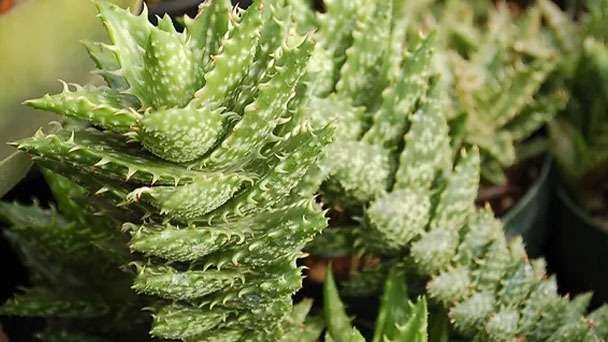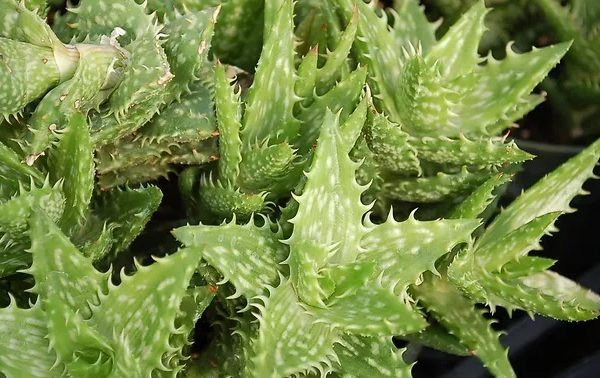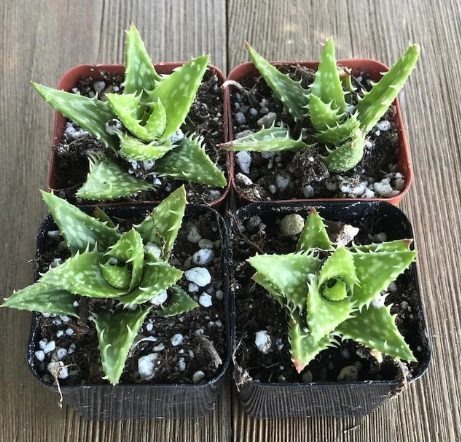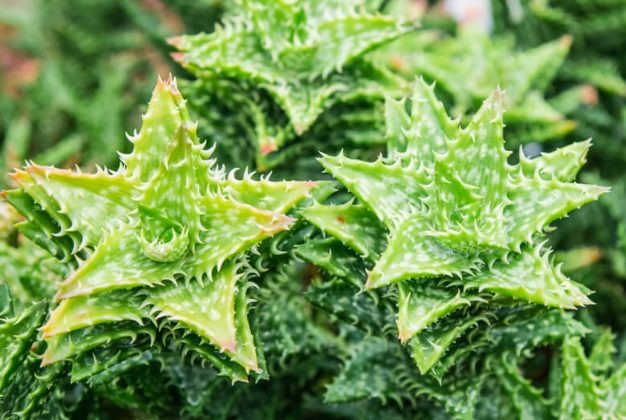How to Grow & Care for Tiger Tooth Aloe
Written by Ivy
Jan 09 2023

The succulent plant known as tiger tooth aloe (Aloe juvenna) is indigenous to South Africa. Cuttings or dividing plant clumps are both viable methods for propagating this plant. Using a sharp knife and making precise cuts is crucial when taking cuttings. When the plant is actively growing, in the spring or early summer, is the ideal time to take cuttings.
About Tiger Tooth Aloe

The main goal when taking care of plants is to create an environment that is as similar to the plant's natural habitat as you can. Because of this, having a fundamental knowledge of the biology of your plants and their environment is beneficial.
Aloe juvenna Brandham & S. Carter is the recognized scientific name for Tiger Tooth Aloe. The Latinized English word for juvenile is the name Juvenna. Due to the initial assumption that it was a younger variety of another type of aloe, this plant acquired the name "juvenna."
Tiger Tooth Aloe is a perennial xerophyte with succulent leaves like other members of the Aloe genus (Newton, 2001). The term "xerophytes" refers to plants that have evolved to live in environments with little or variable precipitation. Succulence, also known as aqueous tissue or water storage tissue in leaves, is a form of xerophytic adaptation (Willert et al. 1992). When creating a watering schedule, it's crucial to take Tiger Tooth Aloe's xerophytic nature into consideration.
The majority of the Aloe genus' native plants are found in southern Africa, where sub-Saharan Africa makes up more than 90% of its landmass. Near the Tanzanian border, East Kenya is home to tiger tooth aloe and about 60 other varieties of aloe. High altitudes (2,300 meters/ 7,550 feet) are where Tiger Tooth Aloe grows naturally.
The Tiger Tooth Aloe can survive in temperatures as low as 40°F, but it will grow better in warmer climates like those experienced by other Aloe species. USDA Hardiness Zones 9 through 11 are suitable for growing Tiger Tooth Aloe outdoors. If you reside in a region with four distinct seasons, you can grow Tiger Tooth Aloe as an annual plant during the summer.
Unless they are placed in front of a bright window, these plants are generally challenging to grow indoors.
How to Care for Tiger Tooth Aloe
Water Requirements
Aloe juvenna favors dry environments for growth, like the majority of other aloes and succulents do. It can go for long periods of time without water, though too much can be harmful.
Allow a few days or weeks to pass between waterings and make sure to thoroughly water your plants. To stop the roots from rotting, make sure the water drains.
Water aloe when the top 1-2 inches (2.5–5 centimeters) of the soil are completely dry for best results. The roots won't sit in water as a result, but they will still be able to hold onto enough water to remain healthy.
Water plants once or twice every two to three weeks. If it's hot outside, plants might need to be watered more frequently.
Above all, avoid allowing aloe plants to stand in water. This will result in the rot or disease of roots. Make sure the soil has adequate drainage at all times.
In the winter, give these succulents less water. Tiger tooth aloe enters a period of natural dormancy during this time, storing energy for the upcoming growing season.
Plants need water once or twice a month in the winter. (Read More: How Often Do You Water Aloe Plants?)
Light Requirements
A lot of light is needed for aloe juvenna maintenance. The majority of aloe species require bright, sunny conditions to thrive.
Aim for 6 to 8 hours of daily direct sunlight. To give these plants enough light if you're growing them indoors, put them close to a south-facing window (or a north-facing window if you live in the southern hemisphere).
Tiger tooth aloe shouldn't be exposed to the sun for longer than eight hours because doing so can burn the leaves.
Grow lights are the ideal substitute for sunlight if it isn't available indoors. Achieve 12 to 16 hours of artificial light per day for the aloe by placing grow lights or lamps 12 inches (30 centimeters) above it.
Your aloe is probably not getting enough light if it begins to stretch or if it begins to grow spindly, skinny leaves.
Temperature Requirements
In temperatures between 65 and 75 degrees Fahrenheit (18 and 24 degrees Celsius), aloe and succulents thrive. Temperatures that are a little higher or lower are acceptable, but preserving them in this narrow range promotes the best growth.
Aloe juvenna can withstand temperatures of up to 90°F (32°C) and as low as 50°F (10°C). Additionally, they can endure these temperatures briefly while also surviving in slightly higher or lower ones.
Plant damage or even death may result from prolonged exposure to temperatures below 50°F (10°C) and above 90°F (32°C).
If the plant is outdoors and the weather turns dangerous, try to bring it inside. If not, cover the plant if it gets too cold and give it some shade and water on hot summer days.
Furthermore, if you reside in the United States agricultural zones 10-11, plants can be kept outdoors all year.
Tiger tooth aloe plants should never be kept in drafty areas. While chilly drafts can freeze them, a constant breeze will dry out the leaves and stems.
Soil Requirements
Aloe, succulents, and cacti all need quick-draining soil that doesn't retain water. Fortunately, there are many different soils available for sale both offline and online that are suitable for these plants.
Here are some examples of aloe soils:
- Cactus and/or Citrus potting mixes
- Soil and Sand mixes
- Perlite or Lava Rock mixes
A small amount of organic matter, such as manure, compost, or decomposing leaves, can be added to the soil to aid in the growth of plants.
Moreover, the top soil layer needs to be covered with a layer of rocks or coarse gravel. This lessens soil movement, prevents soil compaction, and aids in the drainage of water away from the roots.
A drainage hole at the bottom is a must for aloe plant pots. Most succulents cannot tolerate standing water and will begin to rot.
Drainage holes let extra water run off while holding back just enough to hydrate roots.
Tiger tooth aloe prefers slightly acidic soils, to be specific. They can tolerate neutral or basic/alkaline soils as well, though.
Visit thegreenpinky.com to learn more about the best cactus/succulent soils to use.
Fertilizing
Like other aloe plants, Aloe Juvenna doesn't require fertilizer to survive. However, judicious fertilizer application can promote growth.
Look for cactus/citrus fertilizers if you decide to use fertilizer. Heavy liquid phosphorus fertilizers also function well; just make sure to adhere to each product's directions.
Start fertilizing plants in late winter or early spring, right when their natural growing season starts. For a monthly boost in growth and leaf production, add fertilizer when watering.
The use of solid plant foods is another possibility. Over time, slow release pellets aid in ensuring a steady supply of fertilizer.
Replace the plant's soil once or twice every year if you decide not to use fertilizer. This assists in providing the plant with fresh nutrients and eliminates any bacteria or fungus that may have begun to grow.
Propagation
Aloe juvenna is simple to grow and spreads quickly on its own. Care is now simple and enjoyable.
If their care requirements are satisfied, mother plants (the big ones) will gradually produce offsets or pups (little plants). These pups will emerge from the soil and grow from the mother plant.
As they grow, offsets will establish their own roots and be able to support themselves. Use a sharp cutting tool that has been sterilized in alcohol or warm, soapy water before separating the pups from the mother plant to avoid spreading infection.
They can be transferred to their own pots and kept in moist soil while their roots mature.
Tiger tooth aloe can also occasionally grow branches. These are cut off, treated like offsets, and eventually grow their own roots.
Use rooting hormone when propagating branches to increase success. Faster development of robust root systems results from this for the cuttings.
Aloe leaves are a final method of reproduction. The success rate of this approach is low, and it can be challenging to master.
Slice a leaf off at the base, plant it in the ground about an inch (2.5–3 centimeters) deep, and keep it moist to propagate leaf cuttings. Over a period of a few weeks, the leaves should gradually form roots.
In order to increase the likelihood of success, try using rooting hormone if you choose this method.

Division
The division propagate tiger tooth aloe (Aloe vera "Tiger Tooth") is a succulent that is easy to propagate by division. It thrives in soil that is well-drained and receives direct sunlight. It can be grown in containers or as a groundcover. The orange flowers are accompanied by green leaves with white stripes. As long as the plant is not too old and hasn't been pruned back, stem cuttings can be harvested from it. Make a clean cut at the base of the leaf where you will be taking the cutting with a clean blade. After that, the cut end of the stem is allowed to dry before being put in a water container. Within a few weeks, the stem ought to develop roots.
Offsets
Cut off and replant offsets, which are tiny plantlets that grow on the mother plant, to create new plants. Offsets from the mother plant of the tiger tooth aloe are simple to propagate; just take them off, let them dry out for a few days, and then plant them in soil.
Stem Cuttings
You can use stem cuttings to multiply tiger tooth aloe. Remove any leaves from the bottom few inches of the cutting by cutting a 2-3 inch section from the end of a healthy stem. Plant the cutting in a pot with moistened potting soil after dipping it in rooting hormone powder. Put the pot somewhere sunny and give it regular waterings. In a couple of weeks, the Tiger tooth aloe should start to develop roots and fresh leaves. A tiger tooth aloe plant grows slowly and takes about a year to start blooming.
Common Problems With Tiger Tooth Aloe
Yellow Leaves
Watering problems are the most frequent cause of yellow leaves. Check the soil to see if it is drying out sufficiently quickly between waterings if the plant starts to turn yellow. There's a chance the plant is getting too wet and not drying out quickly enough. To solve the issue, change to a soil that drains well and use less water. (Read More: Why Is My Aloe Plant Turning Yellow)
Brown Leaves
Sunburn is the most typical reason for brown leaves. Simply relocate the plant to a more shady area to avoid getting burned. As long as the issue is fixed, sunburn spots on leaves are permanent but do not actually harm the plant internally. If there are any brown edges, you can trim them off or just leave it alone and wait for new growth to appear.
Dried Shriveled Tips
Underwatering is by far the most typical cause of dried tips. The leaf tips will appear brown and dried up. This indicates that the plant's water storage is getting low and that it is time to water. Simply giving the plant a good drink of water should help it recover within a day or two.
Mushy Brown Leaves
Overwatering is usually to blame for mushy, brown leaves. The leaves will become mushy, soft, and translucent, and the plant will appear sickly. You can tell you're overwatering your plant by looking for these symptoms. Reduce the amount of water you give the plant and give it time to dry out and recover from too much water. Wait until the plant has had time to completely dry out before watering. Consider switching to a fast-draining soil if the current one isn't drying out quickly enough. When roots are left in wet soil, root rot can occur. By removing the plant's dead parts after noticing rot, you can still save the entire plant. Save anything that appears healthy and green so you can multiply it and repot it. (Read More: How to Save Overwatered Aloe Plant)
When in doubt, err on the side of caution when watering, particularly if you are unfamiliar with the plant. Keep in mind that it is simpler to "fix" an underwatered plant than an overwatered one.
When Does Tiger Tooth Aloe Bloom
Bright orange-coral flowers are produced by the "Tiger Tooth Aloe," Aloe Juvenna. It's important to remember that not all plants are prepared to bloom, and some may not even bloom at all. A significant portion of it is determined by environmental factors that are out of our control. Make sure they are receiving enough lighting to promote blooms. Make sure the plant receives the recommended care along with the appropriate lighting.
While fertilizing is not required, providing your plants with the nutrients they require will help ensure healthy growth and promote blooms. Flowers require a lot of energy to grow, so giving plants extra nutrients during the flowering season will help meet their nutritional requirements. When plants are actively growing, which is in the spring and summer, is the best time to fertilize. It is appropriate to use fertilizer designed specifically for cacti and succulents or a balanced indoor plant fertilizer mix. Fertilizers work best when applied at a quarter- or half-strength, roughly every two weeks.
In order to promote blooms, plants require the proper environmental conditions as well as a period of wintering. This can be accomplished by keeping them cool and dry during the winter, with temperatures ranging from 35 to 440 F (1.5 to 70 C).
Toxicity to Cats, Dogs Or Pets
Aloe Juvenna toxicity information is difficult to find, but generally speaking, aloes are toxic to cats, dogs, and other animals. Saponins and anthraquinones are the poisonous components of aloes. Aloe Juvenna might contain these ingredients, but I'm not sure. When giving this plant to house pets, use caution if unsure.
Brief History of Tiger Tooth Aloe Cultivation
Aloe juvenna was first described by In a 1979 piece that appeared in the Cactus & Succulent Journal of Great Britain, Peter Edward Brandham and Susan Carter Holmes. At this time, nobody knew where this plant grew in the wild and many thought Tiger Tooth Aloe was actually a hybrid of an Aloe and Astroloba.
A few wild Tiger Tooth Aloe plants were discovered in the Loita Hills in Kenya in the early 1980s, miles away from populated areas. This confirmed that Aloe juvenna is a true species.
The Convention on International Trade in Endangered Species of Wild Fauna and Flora (CITES) protects Aloe juvenna from being traded internationally. In order to ensure that the trade in wild plants and animals does not endanger their ability to continue existing, governments have come to an international agreement known as CITES. The Tiger Tooth Aloe is included in Appendix II, a list of endangered species that also includes species that are not necessarily in danger of going extinct.

Conclusion
Place your Tiger Tooth Aloe where it will receive at least six hours of direct sunlight every day. Although Tiger Tooth Aloe can survive in both partial shade and full sunlight, direct, hot sunlight should be introduced gradually. Like other succulents, you should water your Tiger Tooth Aloe thoroughly and let the soil dry in between waterings.
Aloe juvenna offers an interesting ground cover by trailing over rocks or walls after the thick stems have lost their ability to stand upright. For a rock garden or succulent garden, use it as an edger or ground cover. It also thrives when grown in pots or containers, either by itself or as a component of a succulent or cactus arrangement.
FAQs
Are They Indoor Or Outdoor Plants?
Plants of Aloe Juvenna, also known as "Tiger Tooth Aloe," can flourish both indoors and outdoors. The right potting mix and enough sunlight are essential for their survival, whether they are grown inside or outside.
How Much Sun Does a Tiger Aloe Need?
Tiger aloe requires 6 to 8 hours of sunlight per day, so it is best to keep it partially shaded when grown outdoors in extremely hot climates.
How Tall Does Tiger Tooth Aloe Grow?
At maturity, Tiger Tooth Aloe will reach a height of 12 inches, and when the flowers are in bloom, it will reach a height of 24 inches and have a spread of 3 feet. It has a slow rate of growth and, in a perfect world, might live for at least 40 years.
How Fast Does Tiger Aloe Grow?
When fully grown, this attractive specimen stands between 12 and 24 inches tall. However, it can take five to 10 years to reach mature size as this species also grows very slowly, especially if grown from seed, making it a perfect addition to a smaller space.
Latest Updated
- Benefits of Bugleweed - 7 Science-backed Health Benefits
- Bugleweed Dangers & Side Effects - Is It Poisonous?
- How to Plant Evergreen Trees - What You Should Know
- When to Plant Evergreens - Grow Guide for Evergreen Trees
- 12 Wonderful Evergreen Shrubs for Your Garden
- 12 Popular Evergreen Plants with Pictures for Beginners
- When And How To Prune A Lilac Bush Like a Pro
- How to Grow & Care for Lilac Vine (Hardenbergia Violacea)
- Japanese Lilac Tree (Syringa Reticulata) Care & Propagation Guide
- Shumard Oak Pros and Cons - What to Know
Popular Articles
- Winter maintenance of Antirrhinum Majus
- How to Grow Terminalia Mantaly Tree
- How to Grow and Care for Crossostephium Chinense
- How to grow Antirrhinum Majus in spring
- Peristeria Elata (Dove Orchid) Profile: Info & Care Guide
- Underwatered Snake Plant (Sansevieria Trifasciata) - Signs And How To Fix
- How to Care for Brazilian Jasmine Plant (Mandevilla Sanderi)
- How to Grow & Care for Graptopetalum Purple Delight in Summer
- Rosa Chinensis (China Rose): Plant Growing & Care Tips
- How to Care for Baby Sun Rose (Aptenia Cordifolia)